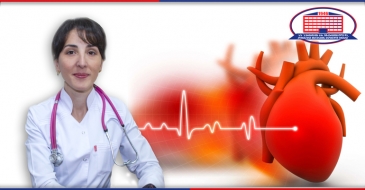Pulmonary thromboembolism is a blockage of a pulmonary artery by a thrombus.
At this time in the lungs, there is a disruption of blood circulation, abnormal oxygen saturation, the danger overtakes other organs and if we deal with the massive thromboembolism, a fetal outcome is possible. Timely diagnosis and adequate treatment are crucial!
Tamar Avaliani, a cardiologist at the National Center of Surgery, talks with us about the thromboembolism.
"The most common cause of pulmonary embolism is a thrombus that enters the lungs from the abdomen, pelvis and deep veins of the lower extremities, rarely from other parts of the body. It may also be located in the heart. An air bubble trapped in the blood, part of the tumor tissue, can also cause a blockage of the pulmonary artery. There is a fat embolism, which often occurs with bone fractures, especially after the fracture of the long bones (femur, humerus, fibula, ulna, radius)”, - says the cardiologist.
- Dr. Tamar, what other risk factors should be considered?
- The most common cause of embolism is a deep vein thrombosis of the lower extremities. Long bed rest, immobilization increases the risk of developing the disease. It is also found in cancer pathologies, especially among patients who are undergoing chemotherapy, in the case of fractures. Bad habits such as smoking increase the risk of blood clotting, i.e. the risk of hypercoagulation, which helps to form a blood clot. Also, excessive use of alcohol contributes to the dehydration of the body, therefore, increases blood viscosity. Weight gain, taking certain medications, especially hormones, and surgical interventions pose a risk of the thrombus.
- What are the characteristic symptoms of the pulmonary thromboembolism?
- The symptoms of pulmonary embolism are varied, it all depends on the area of the lung involved in this process, the size of thrombus, the caliber of the occluded blood vessels and the presence of the concomitant pathology of the lungs or heart. Main symptoms: difficulty breathing, which can develop abruptly, although if we are talking about the chronic thromboembolism, the development of difficulty breathing is gradual. The patient may feel a pain in the chest, which often resembles a heart attack. It is often associated with breathing, aggravated during coughing, exercise, although it does not decrease during rest. A cough may be mixed with blood. Often accompanied by pain in the lower extremities, which makes us think about the deep vein thrombosis of the lower extremities and thromboembolism developing for this reason, as well as an increase in body temperature, general weakness, rapid heartbeat, and loss of consciousness. Surgical intervention performed in the recent past is always a risk for thromboembolism. Because of this, proper patient management before and after surgery is important.
- How is the pulmonary embolism diagnosed at the National Center of Surgery?
- Timely diagnosis of pulmonary embolism is of great importance. This way we can avoid fatal complications. Collecting patient history for the diagnosis is important. The patient's risk factors - complaints help the doctor to think about a possible diagnosis, on the basis of which relevant laboratory or instrumental studies begin: electrocardiography, echocardiography, chest x-ray, computed tomography in pulmonary angiography mode, which is a non-invasive and highly informative method of research, cardiac markers, determination of D-dimer, magnetic resonance research, etc. There are also invasive research methods, such as pulmonary angiography.
- How do you treat the pulmonary embolism at the National Center of Surgery, and what can you say about the prevention methods?
- When managing any disease, preventive measures are of great importance. Surgical or conservative treatment of venous insufficiency of the lower extremities, the use of compression stockings, treatment of deep vein thrombosis, if necessary, the implantation of a cava filter, the use of anticoagulant or antiplatelet therapy during the postoperative treatment, to avoid the development of thromboembolism of the pulmonary artery - all of the above is very important to avoid the development of pulmonary embolism. After the diagnosis, active anticoagulation therapy is initiated, which begins under the control of laboratory data. In severe cases, thrombolysis is used, also surgical thrombectomy may be required. Treatment of patients with pulmonary thromboembolism occurs in accordance with the national guidelines, but in some cases, based on the patient's state of health, additional measures may be required.
Fluid intake is recommended to avoid dehydration, as well as limiting smoking, alcohol intake, and weight correction.
National Center of Surgery address – Tbilisi, Digomi Chachava street N5.
You can contact the Call-center of the National Center of Surgery at 577 11 91 19 or 2 02 25 25;
If you have some questions, you can contact the cardiologist-therapist of the National Center of Surgery Tamar Avalianiat 555 57 55 99.
Wish you health!







